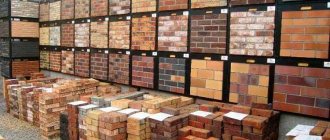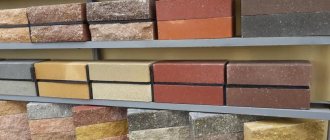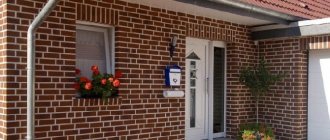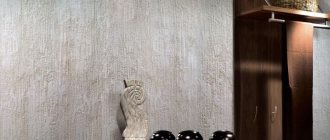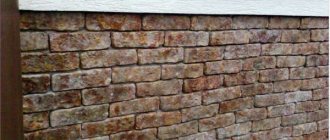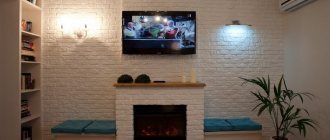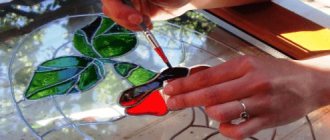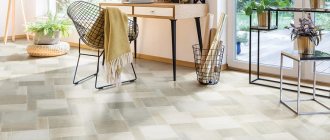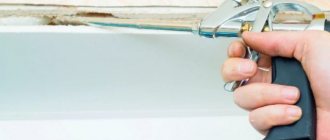An attractive and durable option for finishing the facade of a private house is the use of special facade bricks. It will cost expensive siding, insulating boards or decorative plaster, but such bricks give the house a complete shape.
It’s just that there is now such a variety of bricks on the building materials market that only a builder with 20 years of experience under his belt can figure out how to buy the “right” one. But everything is simpler, the main thing is to know how facade bricks are classified and what advantages and disadvantages each of its varieties has. And even then choosing the best facing brick will not be difficult.
The difference between ordinary and facing bricks
There are ordinary and facing bricks on the market; they differ greatly in price, but the scope of application of the products is radically different. Ordinary is used only for backfilling walls, since it necessarily requires subsequent finishing. It is not suitable for cladding facades for the following reasons:
- there are defects on the surface - chips, cracks, potholes, inclusions;
- low frost resistance - withstands 25-50 freeze-thaw cycles;
- have a high water absorption coefficient;
- unstable geometric dimensions will not allow laying out a perfectly even row;
- uneven coloring.
A wall made of this material requires plastering or facing with façade bricks.
The facing brick has an ideal geometric shape; standards do not allow deviations from the standard by more than 3-4 mm. Most manufacturers try to produce material whose deviations do not exceed 1-2 mm. Among other differences between facing bricks and ordinary bricks:
- flat smooth surface;
- high frost resistance - from 50 to 300 cycles;
- high strength - facing bricks of grades M150-M300 are used for work; for clinker this indicator reaches values of M500-M1000;
- low water absorption coefficient;
- uniform color throughout the mass.
For facing bricks, the main criteria are external characteristics, frost resistance and strength. The façade should not absorb water during rain or be destroyed by minor mechanical impacts.
Criteria such as heat capacity are not important when choosing facing bricks. If it is necessary to improve the thermal performance of a building, it is better to install a layer of thermal insulation between the façade and cladding materials. Despite this, manufacturers produce solid and hollow facing bricks, which have all the necessary characteristics for building a beautiful and reliable facade.
Types of material, which one is better to choose
Facing bricks are produced by firing (various types of ceramic and clinker) and without firing (hyperpressed and silicate), which gives the material completely different qualities. When choosing a material for external wall cladding, the following characteristics are important:
- weight - affects the power and thickness of the foundation;
- strength grade;
- frost resistance grade - the number of freeze-thaw cycles that the material can withstand during 1 season, for external cladding, according to building regulations, cannot be less than MRZ 35 for walls and MRZ 50 for plinths, cornices and parapets;
- water absorption - shows how much moisture the material absorbs within 24 hours when completely immersed in water; materials with a high level of water absorption are not suitable for cladding plinths, cornices and parapets, since when the moisture-saturated material freezes, the front surface of the masonry is destroyed;
- thermal conductivity - needed to calculate the required masonry thickness or insulation thickness.
When choosing cladding and purchasing material, you should familiarize yourself with the manufacturer’s passport for the batch of goods, which indicates these indicators. A high-quality block has a uniform color throughout its entire thickness, without damaging the integrity of the edges and the front layer. A pink tint of ceramics is a sign of underburning; too dark or black color (except for colored and clinker) indicates overburning.
Ceramic
Ceramics is the oldest invention of mankind in the field of artificial building materials. Ordinary ordinary bricks are produced by semi-dry or plastic pressing from clays with various additives, followed by firing at t = 900-1000 ° C. Unlike ordinary, facing material must have:
- increased frost resistance - minimum value Мрз 35;
- minimal moisture absorption - 2-6%;
- increased strength - from M 75;
- vapor permeability - ceramics have the ability to “breathe”, that is, release excess moisture into the atmosphere.
Ceramic facing bricks are made with different finishes on the front surfaces; they can be textured, glazed or engobed. By applying the front decorative layer, the brick is given a wide range of colors - from white to black.
Ceramic bricks are produced solid and hollow with different numbers of voids. Voids reduce the weight of the masonry and thermal conductivity, but make it more vulnerable: in a harsh climate with a large number of freeze-thaw cycles, bricks with a low frost resistance grade quickly collapse, and peeling of the front surface occurs in the area of the outer row of voids.
The weight of a solid bar is 1650 kg/m3, a hollow bar is from 1350 to 1480 kg/m3.
Clinker
Clinker bricks have been made for more than 200 years from special fireclay clays with various mineral additives at elevated temperatures (up to 1300°C) and continuous firing. Available in solid and hollow, single, Euro-format, narrow, thin or figured. Clinker differs from conventional ceramics by improved characteristics:
- it is stronger (from M 150);
- heavier (1800-2000 kg/m3);
- has minimal water absorption (2–3%);
- increased frost resistance (from Mrz 75).
In the clinker manufacturing process, special shale clays, only mineral additives, manual molding or extrusion, and a large amount of energy are used. The production method makes the cost of the material significantly higher than conventional ceramics.
The appearance of clinker depends on the production method and additives: handmade and fired in authentic kilns, it has uneven edges and an interesting texture, with spectacular color transitions.
The clinker produced on modern lines has an ideal geometric shape. The color range depends on the mineral pigments included in the pressing mass - from almost white to dark red, brown and black.
Clinker brick is a real aristocrat in the world of facing materials.
Silicate
Sand-lime brick is made from a mixture of quartz sand, lime and additives using the autoclave method, which makes the cost of the material significantly lower than that of ceramics. In terms of its characteristics, sand-lime brick is significantly inferior to clinker and ceramic:
- frost resistance - Mrz 25 - 35;
- water absorption - 13-15%;
- greater weight - 1800 kg/m3.
ATTENTION: Due to low frost resistance and high water absorption, sand-lime bricks are prohibited from being used for masonry and cladding of the most heavily loaded and weather-exposed structures - plinths, cornices, parapets, and various protruding elements.
Nevertheless, silicate bricks are actively used for wall cladding due to their good geometry, fairly wide range of colors and low cost.
Hyper-pressed
The material obtained by hyper-compression surpasses even clinker in its characteristics: strength is higher than natural stone, zero water absorption, fire resistance.
Hyper-pressing technology involves exposing the molded mixture to high pressure at elevated temperatures, resulting in the fusion of the components at the molecular level. Production uses a large amount of electricity, which results in a high cost of the product.
Hyperpressed bricks are produced in a wide variety of shapes, textures and colors. It is used both in the exterior and interior of buildings. It can be used for lining stoves, fireplaces and chimneys.
Ceramic facing bricks: advantages and disadvantages
Ceramic facade bricks are made from clay, the blanks are molded, acquire an ideal geometry and fired in kilns at temperatures of 900-1000ºС. The result is products that meet the most stringent requirements. Among the advantages of facing ceramic bricks:
- balanced price;
- good vapor permeability;
- good adhesion of the masonry mortar makes masonry easier.
Among the disadvantages of this type of facing brick is high water absorption, which can reach 12%. This is significantly lower than that of ordinary brick, but with constant high humidity it can cause cracks. Frozen water destroys the material, despite its high strength characteristics.
Another disadvantage is the presence of voids; when laying, this leads to excess consumption of mortar. It is necessary to choose a stone with the smallest cross-section of round or rectangular holes.
Plaster or brick: how to choose?
Facial decoration performs not only a decorative function, indicating the aesthetic taste and well-being of the owner, but also solves a number of practical problems: thermal insulation of the house, protection of load-bearing structures from moisture and freezing, durability of the structure, and others. If the wall cladding is chosen incorrectly, various defects may appear, reducing thermal efficiency and quality of finish.
Which is better: a facade made of brick or plaster?
Facing plaster is often used for finishing buildings. The composition of this building mixture has changed quite a lot over time, but the main function has remained the same - leveling the surface and protecting the facade. The main advantages of plastering walls include the coating's resistance to water, effective removal of condensate from rooms, aesthetic appearance, high adhesion to any substrate, and a large selection of color combinations.
It is also worth noting that plastering can be done with additional insulation of external walls. Mineral wool or polystyrene foam boards are used as thermal insulation, which are rigidly attached to the surface to be finished. To increase strength, a base reinforcing layer is installed on top of the insulation using facade fiberglass mesh, after which facade plaster is applied. This system was called a “wet facade” due to the presence in the technology of processes associated with dry building mixtures that require mixing with water. The most popular in individual house construction are Ceresit plaster systems on mineral wool and polystyrene foam boards.
Hyperpressed facade brick
Produced from limestone screenings using Portland cement as a binder. Thanks to high pressure during molding, the ideal shape is achieved. Firing is carried out at low temperatures. Among the advantages:
- low price;
- wide range of colors;
- the presence of collections with a corrugated surface for decorative plaster, “torn stone”, marble.
Hyper-pressed facing bricks look impressive and unusual. This material has a number of disadvantages that must be taken into account:
- the smooth surface has little adhesion to the mortar, so it is necessary to use special mixtures or give preference to hollow facing bricks;
- During operation, microcracks appear on the surface, which leads to a decrease in frost resistance and strength. It is recommended to periodically treat the surface with water repellents. Stone with a textured surface has the greatest tendency to form microcracks;
- has low vapor permeability, this complicates the design of the external wall and requires the installation of a ventilated facade;
- high thermal conductivity significantly reduces the thermal performance of external walls.
Increased operating costs are compensated by a low price, which is why hyperpressed facing bricks are in demand when implementing original architectural projects.
Tips for purchasing, transporting and storing bricks
If they are followed, it is possible not only to make a purchase more profitably, but also to preserve the material in proper form until it is used. For this reason, the following must be taken into account:
- Buying bricks. It is best to calculate in advance how much material will be needed to completely cover the house. This allows you to save a lot, because if you purchase a large number of products at the same time, you can often get a discount, as well as cheaper or even free shipping. In addition, when purchasing bricks from one batch, there is a minimal likelihood of a color mismatch and some of them having stains. Another advantage of wholesale delivery is the elimination of the material being located in one of the warehouses that act as transshipment points, where it can also be damaged during additional unloading or loading, and in this case the delivery time becomes shorter.
- Storage. It must be done in such a way that the penetration of moisture into the packages from the ground or precipitation is completely excluded, especially if the material is purchased in advance and it is planned to winter it outside.
- Transportation of hyperpressed bricks. If preference is given to it, then it is extremely important to take into account the production date of the material, because products that were manufactured in less than 15-20 days can be negatively affected by transportation. The reason is that only after the specified period of time does a brick of this variety acquire 80% of its declared final strength, which makes it possible to reduce the likelihood of damage during transportation to a minimum.
After finding out how to choose facing bricks for a house and the characteristics of the main types of material, it becomes much easier to decide on the option that is suitable for yourself and purchase it, taking into account the accompanying important nuances.
Video:
Clinker brick: features and advantages
Clinker bricks appeared in Holland more than 200 years ago. It is made from plastic clay. The technological feature of the process is firing at high temperatures, which reaches 1300ºС. The result is a stone with unique properties:
- high strength - you can purchase clinker bricks M500, M800, M1000;
- minimal water absorption;
- does not absorb automobile oils and fuel, liquids with dyes;
- high frost resistance;
- wide selection of formats, colors, textures.
Clinker brick was created for paving streets; its characteristics were highly rated and began to be used for cladding the facades of prestigious mansions.
The most significant disadvantage of clinker facing bricks is the high price. Other features include:
- low water absorption requires the use of special masonry mortars - low-moving, with a low water content. Working with them is difficult and requires skills. The recommended daily masonry rate is no more than 5 rows in height;
- low vapor permeability requires increased attention to the ventilation of a building lined with clinker bricks.
The disadvantages of clinker bricks are fully compensated by their spectacular appearance and long service life, which exceeds 200 years.
Which brick is better for cladding a house: win-win options
It's no secret that the well-known brick can be used for construction and facing. And here it is important to understand why it is necessary to use only a special type of brick for cladding a building. It is the facing brick that plays an important role, retaining heat and protecting the house from adverse weather conditions. In addition, it is worth noting the fact that such building material gives a beautiful appearance to the building.
Thanks to facing bricks, we have the opportunity to give a beautiful appearance, since today there is a wide variety of textures and colors of this material. Particularly popular is Zheleznogorsk brick, which has been sold in Russia for almost thirty years.
Which facing brick should you choose?
There are several options that are suitable for cladding a house. And in this article we will briefly talk about each of them:
- Ceramic brick. This type of facing material is environmentally friendly. And also quite acceptable sound and heat insulation. As for strength, it is possible to purchase material grades from M125 to C800. The undoubted advantage of this brick is its cost.
- Clinker brick is an ideal option for creating an aesthetically beautiful facade. The average strength of this material is M350. Compared to ceramic bricks, the clinker version is characterized by high frost resistance and low water absorption. Among the disadvantages, one can only note the high cost of such material, but it is worth it.
- Hyperpressed brick is a good alternative to clinker. This type of facing material is not inferior to clinker, and the strength of the masonry is much higher than that of ceramic. But such bricks have a lot of weight and also have high thermal conductivity. Quite a good option for creating a textured facade.
- Sand-lime brick is environmentally friendly, has good strength and frost resistance. And to all this, the cost of such material is quite low, which makes sand-lime brick the most popular.
Facing brick and design features
High competition in the market has led to the emergence of hundreds of types of facade bricks, which differ in color, format, and surface features. For facing materials, appearance is one of the main selection criteria. The design of the facing brick must correspond to the architectural features of the building. It emphasizes the status of the property owner and indicates that he has a sense of taste.
The following types of facade bricks are produced:
– an exclusive material, each stone has a front surface with a complex relief, which is formed by hand. The work is carried out using technologies used many centuries ago. This type of facing brick is suitable for premium real estate, the architecture of which is made in a castle style. The process of forming facade bricks is labor-intensive, the cost is the highest in its category;- textured – has a surface like “torn stone” or decorative plaster, is produced on automated lines, so the design of each facing brick is similar for its batch. Used in the implementation of original projects in a castle, classical style;
- torquetted – before firing, the front surfaces of the façade brick are sprinkled with mineral chips, resulting in the formation of an original texture. The overall structure is formed as a result of high-temperature firing, so the crumbs do not crumble. The only drawback is that it is difficult to maintain; this material is not recommended for regions characterized by dust storms. Facing brick has a unique look and can be used for projects in any architectural style;
- engobed – a ceramic solution of a contrasting color is applied to the surface of the dried brick, after which the blanks are fired. As a result, the stone can be given any color, and with incomplete surface treatment, unique color transitions can be created. When sintering ceramics with brick, the strongest possible bond is formed and all the characteristics of the base material are preserved;
- glazed – the front side is decorated with glaze with a glass sheen. The technology allows you to experiment with colors, and the facade brick receives additional protection from moisture and mechanical stress.
Classic ceramic facing bricks are red-brown or beige in color. Adding natural pigments allows you to change the shade. Brick factories produce yellow, brown, white and gray stone. A wide range of colors allows you to give the facade the color that best matches the chosen architectural style.
When choosing, you must give preference to facing bricks from the same batch. The final shade largely depends on the firing temperature and may differ between products from the same manufacturer. If it is not possible to purchase the entire volume from one batch, then before laying it is recommended to mix facade bricks from different pallets in order to avoid spots of different colors on the wall.
How much does it cost
The cost of cladding material depends on the type, characteristics and location of the manufacturer.
The cheapest option is lining with white silicate bars: raw materials for production are available everywhere, the steaming installation does not take up much space, and energy costs are low. The price of white sand-lime brick starts from 9 rubles/piece.
Ceramic facing bricks have a wide range in cost: products from the Revda plant (Ural) from 8 rubles/piece. up to 78 RUR/pcs. imported production.
The cost of clinker starts from 70 rubles/piece. produced in the Russian Federation up to $254 per m2 of Quebec clinker, size 230x105x71, white.
Prices for hyper-pressed material start from 12.5 rubles/piece. for a narrow format (actually 22 mm thick tiles, up to 71 rubles/piece for a one-and-a-half-size product.
Dimensions and shape of facing bricks
Facade bricks are produced as single, one-and-a-half and double. Single facing bricks are in greatest demand. This is due to the fact that its format allows you to make the masonry pattern more attractive with small wall sizes. The material is used for cladding private houses, commercial and municipal real estate up to 2-3 floors high. One-and-a-half and double facing bricks are used in the construction of multi-story buildings.
European and American standards differ from Russian standards. The domestic market mainly sells bricks of the NF format. It has dimensions of 240x60x71 mm, which are close to the dimensions of a single brick.
The solid façade of a building in the minimalist style is being used less and less. Architects at the design stage propose decorating buildings with decorative elements - half-columns, cornices, platbands. This gives the buildings an individual look. Manufacturers of building materials produce shaped facing bricks for arranging complex facade elements. There are a variety of options available that differ from the traditional rectangular shape:
- with a rounded butt, the radius of curvature can have different diameters;
- with a cut corner;
- beveled along the length at a certain angle;
- beveled with a protrusion, which is necessary for fixing to the window frame;
- the poke is beveled at two angles;
- wavy;
- radial;
- with a concave semicircular corner;
- with profiled corner.
If the facade project contains complex decorative details, then it is necessary to choose a facing brick, the collection of which contains all the necessary shaped products.
Main Dimensions
The dimensions of domestically produced facing bars are determined by GOST 530-2007, which divides the dimensions of products as follows:
- single brick - 250x120x65 mm;
- one and a half - 250x120x88;
- double - 250x120x138;
- narrow - 250x60x65;
- thin - 250x22x65.
The document gives the manufacturer the right to produce products of other standard sizes as agreed with the buyer. In addition to rectangular bars, cladding material is produced in various curly rounded shapes for laying out arches, frames, and fillets.
ATTENTION: EU countries produce products according to their own standards; the brick has a thickness reduced by 0.7.
Quantity calculation and budgeting
Before you start choosing facade bricks, you need to calculate its quantity. To do this, you will need to calculate the area of the external walls, subtract the area of window and door openings from the resulting value. Multiply the resulting value for the area of the brickwork by the number of bricks in one square meter. This parameter does not have a constant value, since each craftsman has his own thickness of the seam in the masonry. When working with a single brick, its quantity per square meter of masonry is 51-56 pcs. Imported face brick standard NF is slightly smaller than domestic single stone. There are 60-65 pieces of this brick per square meter of masonry.
Having decided on the quantity of bricks and the budget for facade work, you can understand in what price range you should choose the material. If the products of domestic factories cost an average of 15 rubles per piece, then the cost of European facing bricks often exceeds 75 rubles. Taking into account the larger amount of material and the need to use special masonry mortars, the cost of facade work may differ by 5-10 times. Price becomes an important factor in choosing facing bricks.
Review of popular manufacturers
There are a lot of manufacturers of facing bricks of any type in the Russian Federation. The most popular among them:
- Ryazan Brick Factory.
- Golitsynsky Brick Factory.
- Slavic brick.
- Staroskolsky conservatory.
- MKZ (Moscow).
- Don Dawns.
They mainly offer ceramic and hyper-pressed bricks - they are the most popular among consumers. The average cost is up to 15 rubles per block (hollow with through holes). In terms of performance characteristics, it is not inferior to foreign blocks (the same strength class is used - M150 or M200 ). But what Russian manufacturers have problems with is design - compared to products from the same Bauer , their bricks look completely inconspicuous.
Hyper-pressed. After only 2 years from the moment of operation, cracks appeared in it due to the action of moisture and regular temperature changes.
MKZ and Ryazan plants also produce clinker bricks, with different block sizes. The average cost is from 45 to 55 rubles per block. Nothing remarkable in terms of design, visually it looks like ceramic, but with a smooth surface without notches (in full compliance with GOST standards).
As for foreign manufacturers, products from the following manufacturers are in demand in the Russian Federation:
- Terca (ceramic).
- Lode Janka (also ceramic).
- Regal Blend Muhl (clinker, including hand-molded).
- Rauf.
Ceramic brick from Lode Janka. The manufacturer assures that in terms of reliability and durability, this brand is no worse than clinker, and is used, among other things, for the construction of stoves
Of course, imported building materials are many times more expensive. But in terms of quality, they are no different - they comply with ISO quality standards, which are almost similar to GOST. But in terms of design, imported products are the clear leader. Especially Dutch and German manufacturers ( Daks Baksteen, Lode, Rauf ). The price range of their bricks is wide. The minimum price is 45 rubles per block (ceramics), the maximum is over 140 rubles per block (clinker, for example, Terca Safari solid with manual molding).
Material selection
Having decided on the budget and price of the material, we begin to select facing bricks. The procedure is simple:
- color and texture are selected - we are talking about the facade - the calling card of the house, so it is necessary to pay special attention to visual parameters. They must correspond to the architectural style of the project, the color of the facade must be combined with the shade of the roofing material;
- practical parameters are analyzed - preference is given to facing bricks with a strength grade of M200 or more, frost resistance should be at least 50 cycles;
- design characteristics are determined - it is better to give preference to solid artificial stone, this will reduce the amount of cement mortar used. If this is not possible, then the hollow facing brick should have holes with a minimum area.
In all respects, clinker facing bricks have advantages. This material is available in a wide range of colors and can have any surface texture. The basis of the range is solid artificial stone, which allows reducing the consumption of special masonry mortars. The service life is more than 100 years, this is explained by high strength and low water absorption. The only drawback is the price, but if it suits the buyer, then it is better to give preference to clinker.
After the final selection, it is recommended to purchase the entire batch of products at once. This solution has several important advantages:
- transportation costs are reduced, many companies provide free delivery for large volumes;
- facing bricks from the same batch are purchased, this will eliminate the need to control the color in order to avoid stains on the wall;
- Transshipment of products at intermediary warehouses is eliminated; large quantities are delivered to the buyer from the factory. As a result, the risk of mechanical damage during loading and unloading operations is reduced.
When purchasing, it is worth checking the date of manufacture of the façade brick. Preference should be given to material that is more than 20 days old. Such artificial stone has already gained more than 80% of its strength; its transportation will not lead to mechanical damage.
Why wall decoration is important
Any homeowner wants their home to last a long time with minimal repair and maintenance costs. Of course, if the cottage is built according to the latest building codes, insulated in accordance with climate standards, lined with clinker tiles or plastered, then it does not need additional protection.
When it comes to old buildings made of wood, wood materials or porous blocks of lightweight concrete (foam concrete, aerated concrete), protecting the outer surface is a necessity. Made of brick, the outer cladding performs several functions:
- protection from adverse climatic factors (precipitation, high and low temperatures, wind);
- improvement of thermal characteristics;
- improvement of appearance.
The industry produces several types of bricks with different characteristics, designed for different operating conditions. In order not to make a mistake with your choice, you should study their basic properties.
Brickwork efflorescence: prevention and care
A respectable house with a facade made of facing bricks can change its appearance when efflorescence appears. Large white spots negatively affect the appearance. The likelihood of their occurrence can be reduced at the construction stage. To do this you need:
- use additive-free cement when making masonry mortar;
- sand and water should not contain water-soluble salts;
- when laying, use a “hard” mortar with little mobility;
- do not use antifreeze additives; it is better to carry out work in the warm season;
- do not allow the masonry mixture to get on the front surface;
- Every day, after work, cover the masonry with waterproof material;
- prevent freezing of the masonry during the construction phase.
If efflorescence appears, it is not recommended to wash it off with water or wipe it off. It is imperative to use special compounds. They will remove efflorescence, reduce the rate of its further manifestation, and will not cause damage to the facade brick.
Which brick to choose for cladding when building houses in Moscow - hollow or solid
The construction of houses in Moscow and the Moscow region often includes brick cladding: this type of finishing gives the building a solid appearance, and also adds strength and insulation. For facing work, you can choose solid (monolithic) or hollow brick. Which option is better?
In rare cases, when it is necessary to strengthen load-bearing walls or the house is located on a very damp area, builders may recommend using monolithic material, but it is dangerous to use it for old buildings. Most often, hollow brick is chosen for cladding - it serves as a good heat insulator. In addition, this material insulates sounds better and is lighter.
During the construction of a country house in the Moscow region (in Barvikha), hollow brick was used to decorate the cottage, which reduced the load on the walls and foundation. completed the laying of the foundation and erection of the building under the roof, arrangement of communications and interior finishing for finishing.
Despite the great popularity of its hollow counterpart, solid bricks for cladding are also produced. You can buy beautiful glazed, original engobed or textured brick. The construction of turnkey country houses according to an individual project is a way to select the optimal materials and create the ideal project.
Prices for the construction of country houses
will fulfill your order in a gas silicate or ceramic block with facing brick finishing at prices that are 10-15% lower than the market average. This is possible thanks to the complete rejection of subcontracting and direct contracts for large wholesale supplies of building materials. We have already built more than 500 cottages! The price is indicated per m2.
| Construction materials | Price of a house box (foundation, walls, roofing, screed) | Price “for rough finishing” (frame + windows, roof insulation, partitions, stairs) | Price “for final finishing” (for rough finishing + electrical wiring, heating, drainage) |
| Gas silicate block + facing brick | 18,000 rub. per m² | RUB 20,500 per m² | 23,000 rub. per m² |
| Ceramic block + facing brick | 19,000 rub. per m² | RUR 21,500 per m² | 24,000 rub. per m² |
In addition to the individual design service, on the SVS website you can find projects and prices for the construction of turnkey country houses: this is faster than searching for individual solutions. We can also provide you with the service of selecting a plot for a cottage. The construction of turnkey country houses is carried out in compliance with all norms and standards, according to a white contract. Customers' rights are fully protected!
The construction of monolithic cottages is gaining popularity because it allows you to create a durable house designed for at least 100 years of operation. Such construction occurs very quickly, which is also an undeniable advantage. However, the microclimate of a private house made of reinforced concrete will be unhealthy if proper ventilation is not organized, so the most important stage of construction is design.
The construction of houses in Moscow and the Moscow region often includes brick cladding: this type of finishing gives the building a solid appearance, and also adds strength and insulation. For facing work, you can choose solid (monolithic) or hollow brick. Which option is better?
Construction of a turnkey log house begins with design and budgeting. At this stage, the area, type of log house (paw, bowl, okhryap), location of windows, architecture and much more are determined.
Maintenance of facades made of facing bricks
Facade brick is an unpretentious and durable material; it does not require complex maintenance. When using conventional ceramic bricks, it is recommended to treat the surface with water repellents every two years. They prevent water from penetrating into the pores, which protects against cracks. Thanks to this care, the facade will remain in perfect condition for decades.
Clinker facade bricks do not require routine maintenance. If necessary, periodically remove small efflorescences, which often resemble lichen or fungus. For care it is better to use special formulations.
Hyper-pressed facing brick requires constant maintenance; without treatment with a water repellent, large cracks appear within 3-5 years, leading to the destruction of the artificial stone. If you do not take care of the facade, then in 10-15 years you will have to change it.
Conclusion
Clinker facing brick is the best choice for the facade of a private house or an elite store. The material has ideal performance characteristics, a long service life and is easy to maintain. In Russia, clinker production is just beginning to develop. The material is produced by several factories, but the appearance of these products has already reduced the average cost of facing clinker bricks. It will become more accessible in the coming years.
Ceramic brick is much cheaper than clinker, but requires periodic maintenance. The diversity of this facade material allows it to be used in various architectural projects. Hyperpressed brick requires regular maintenance; it is better to use this artificial stone in dry climates. The right material will allow you to build a beautiful and cozy house that will become a family home for several generations of the family.
Pros and cons of brick facades
First, let's look at the practical advantages of brick facades. The main reason for the widespread popularity of using facing bricks in exterior decoration is a solid list of high technical characteristics and qualities. What does the consumer need from a façade? Reliability, resistance to precipitation and other adverse factors and long-term, defect-free operation. The brick fully meets all these requirements. Even a façade lined with metal is unlikely to withstand competitive comparison with a brick one in terms of durability, not to mention plaster.
KodokopatelFORUMHOUSE user
With plaster, the main ambiguity is durability. Brick, built and forgotten. Rain, snow, sun - it doesn't matter. If suddenly there are some small defects, then sometimes they even improve the house, but defects on the plaster are not aesthetically pleasing.
Since we are talking about aesthetics, the visual component of brick, as a designer finishing material, is also at its best. Brick is presented on the modern market in a wide color palette, in several standard sizes and with different surface textures. So, with a little imagination and a little desire, you can not only make a reliable cladding of the house, but also give it any stylistic direction from noble antiquity to modernity.
However, brick cladding also has its disadvantages, which would be unfair not to mention:
— Large weight, which requires serious design preparation and the construction of a reinforced foundation. Traditionally, this is the first limiting factor. If a private developer does not take it into account or does not fully appreciate the importance of the moment, with a high degree of probability it can be argued that he risks encountering serious and even fatal problems for the house.
— The complexity of the work and high requirements for the qualifications of builders. Can this be called a full-fledged disadvantage? Most likely not, to a greater extent it is a limiting factor or a risk factor, since there are not enough smart workers with steady hands and an understanding of technological aspects for everyone.
Miracl635FORUMHOUSE user
A good mason will lay out ordinary bricks in such a way that you will not notice the “dance” of the size. A bricklayer who is still studying (or worse, who does not want to study) will lay an ideal brick crookedly.
— There is a wide variation in the quality of bricks, as well as the likelihood of hidden defects that are not obvious upon purchase. We'll talk about the most common defects later, but for now, general buying advice:
Ilya EfremovTechnical specialist of TD BRAER LLC
“The best option is to purchase products from official distributors or directly from manufacturers. It is in this case that the buyer gets the opportunity to purchase quality material. For bricks, quality is very important, which is ensured: 1. Due to compliance with production technology and good technological equipment of the enterprise. 2. Due to good raw materials. Choosing clay for brick is also not an easy task; this natural material should take into account such properties as plasticity, non-caking, fusibility, which in turn affect water absorption, frost resistance and other characteristics that are most important for facing bricks.
In addition, purchasing material from “officials” provides reliable feedback from the supplier, which not only provides information support, but also makes it easier to handle complaints in case of quality problems.
Voting: best brick manufacturer
Which brick manufacturer would you choose or recommend?
GKZ
41.18 % ( 7 )
LSR. Wall
0.00 % ( 0 )
NZKSM
0.00 % ( 0 )
SK
5.88 % ( 1 )
RKZ
0.00 % ( 0 )
MSTERA
23.53 % ( 4 )
Housing and communal services
5.88 % ( 1 )
KS-Ceramic
0.00 % ( 0 )
KKZ
5.88 % ( 1 )
LSZ
5.88 % ( 1 )
YAZSK
0.00 % ( 0 )
VKSM
5.88 % ( 1 )
MZSK
0.00 % ( 0 )
CHZSK
0.00 % ( 0 )
TCSM No. 2
5.88 % ( 1 )
Hyperpressed brick
0.00 % ( 0 )
RiK
0.00 % ( 0 )
Filling
There are three types of bricks, if the filling of the brick is taken as the main criterion.
- Full-bodied. They do not have any holes or chambers, which increases strength, but at the same time reduces heat retention. Such bricks always weigh a lot.
Example of solid brick - Hollow. These bricks have chambers and/or holes. This allows you to retain more heat, eliminate noise, and make the material lighter and cheaper. Minus - the brick becomes more fragile.
Example of hollow brick - Porous. It is created using a special technology, the essence of which is to mix clay and wood sawdust, shape and burn. The wood will burn, forming pores that improve the thermal insulation properties of the material. The disadvantage of such a brick is that it is inconvenient to work with and the price of such a brick is quite high.
Example of porous brick
Manufacturing technology
Manufacturers produce hollow and solid bricks. Each type has its own characteristics. Hollow retains heat in the building. Solid is used if it is necessary to ensure the strength of the structure being built.
By choosing a high-quality cladding material suitable for the climatic conditions, you will be able to create a beautiful and modern look for your home. But you need to remember - you shouldn’t save on buying bricks. Cheap products may turn out to be of low quality, produced in violation of technology.
Wall cladding with bricks of different colors
In the matter of coloring, if the facing brick is made by hand, too much dye will deteriorate the strength of the product, and too little will deteriorate its color. We recommend following GOST standards. Moreover, the smaller the surface of the cladding, the worse the shades of the gamut are distinguished on it.
Small elements of the house should be faced with bright colors, for example, yellow silicate facing bricks, the dimensions of which we gave above. Brown brick houses may appear black if the shade is dark. Another subtlety: different colors together can look different, that is, with equal brightness, their tones can change places. With Bavarian masonry this point is significant. At the color boundaries, the edge becomes more saturated: light edges become lighter, and dark edges become darker.
The meaning of colors on human emotions
On a subconscious level, colors can evoke different emotions and associations in us. Namely:
White color
.
Means peace, solitude, serenity, purity, perfection, chastity.
Black.
Considered mysterious and exclusive. A color that hides something behind itself.
Red color.
Aggressive, active, annoying, exciting. Forces action.
Orange and yellow.
The color is warm. Represents intelligence, knowledge, freedom, intelligence.
Green.
Nature and harmony. Considered calming.
Blue and light blue.
Purity, severity, coolness, sincerity, devotion.
Violet.
Majestic color. Means experience, wisdom, creativity, feelings.
By the way, the science that studies colors is called “Colorimetry”.
To design the exterior of your home, you can choose the color that expresses your essence and views!
You can see what houses made of different shades of brick can look like in the “our objects” section by following the link.
